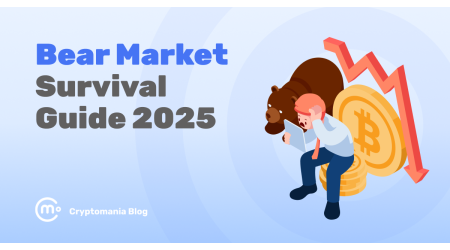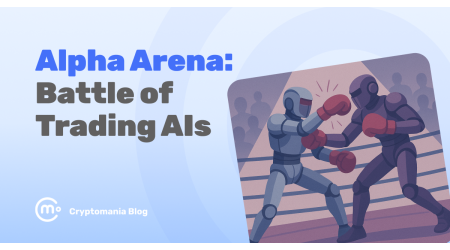Privacy Coins Surge 80% as Zcash, Dash & Aster Lead a Revival
Vuk Martinovic
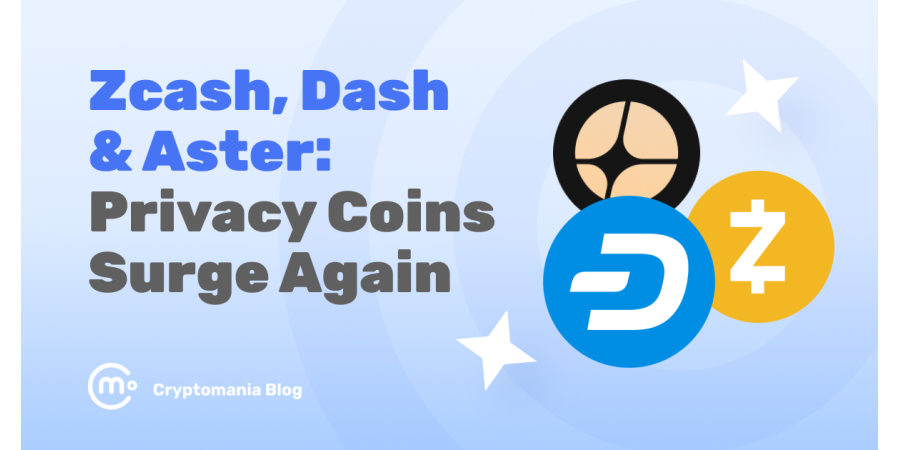
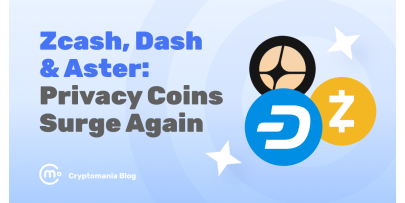
Privacy coins have quietly turned into one of the biggest surprises of the month. Zcash, Dash, and even Aster have all jumped significantly. And traders who ignored this sector for years are suddenly rushing back in.
The Zcash price chart alone shows something that nobody expected. And it’s raising a bigger question: why are privacy-focused projects exploding now, after so long in the background?
In this article, I’ll break down:
- What’s really driving the surge
- Why these three coins are leading it
- What it means for anyone watching the privacy coins crypto sector heading into the next cycle
Let’s get started!
What are privacy coins?
Privacy coins are cryptocurrencies designed to hide sensitive transaction details.
Instead of showing who sent money, who received it, and how much was transferred, privacy coins use special cryptography to keep that information concealed.

This makes them different from Bitcoin or Ethereum, where everything is visible on the blockchain.
How privacy coins work
Most privacy coins rely on techniques like zero-knowledge proofs, transaction mixing, or stealth addresses. These methods allow users to prove a transaction is valid without revealing the data behind it.
Zcash, for example, uses zk-SNARKs to create shielded transactions. Dash uses CoinJoin-style mixing. Other privacy-focused networks use ring signatures or hidden balances.
Top privacy coins today
Some of the top privacy coins include Monero, Zcash, Dash, Firo, and newer projects exploring zero-knowledge infrastructure.
Each takes a different approach to anonymity, but the goal is the same: financial privacy in an industry where transparency is the default.
This renewed interest is also pulling in traders who are researching “what are privacy coins” or exploring the broader privacy coins crypto sector for the first time in years.
Why the surge now?
Privacy coins have rallied before, but this month’s move feels different. The surge across Zcash, Dash, and Aster comes from a mix of:
- Market timing
- Upgraded tech
- Shift in trader psychology
Regulatory pressure is increasing
Global regulations have tightened over the past year. More exchanges require advanced KYC, some regions added extra reporting rules, and OTC desks are applying stricter identity checks. When privacy shrinks in the mainstream market, interest naturally flows toward assets designed to offer anonymity — a trend we also covered in our recent blog post on non-KYC exchanges.
This created a setup where people began rediscovering older privacy coins. And they’re again searching for Zcash crypto and similar queries for Dash.
Technical breakouts after long downtrends
Zcash and Dash traded sideways for years. Their charts built massive consolidation ranges, and once buyers stepped in, both coins broke through multi-year resistance levels. Long consolidations often lead to sharp upside once momentum shifts, and that’s exactly what happened here.
Traders looking at the Zcash price chart saw a clean breakout with strong volume. Dash followed with its own breakout shortly after.
High-profile catalysts
Several events amplified the move:
- Well-known investors highlighted privacy coins again
- Analysts posted bullish long-term projections
- Aster received renewed attention thanks to exchange-related momentum and zero-knowledge development updates
These catalysts pulled the entire privacy niche upward. It wasn’t focused on just one specific coin.
Market rotation into overlooked sectors
During periods when Bitcoin trades sideways, traders often rotate into narratives with upside potential. Privacy coins were heavily undervalued, lightly covered, and largely forgotten. That made them a perfect candidate for a high-momentum rotation once the first big move started.
Zcash (ZEC): the leader of the privacy coin revival
Zcash is the project at the center of this month’s breakout. It’s the coin that moved first, moved the hardest, and pulled the entire privacy narrative back into the spotlight. And because so many traders started looking into it, it quickly turned into the main driver for the sector.
What is Zcash?
Zcash is a privacy-focused cryptocurrency that uses zero-knowledge proofs (zk-SNARKs) to let users send transactions without exposing amounts, senders, or recipients. It offers two types of addresses:
- Transparent addresses (similar to Bitcoin)
- Shielded addresses (fully private)
This optional privacy design is one reason Zcash stayed listed on more exchanges than fully-private coins like Monero, which helped liquidity during the rally.
Why Zcash rallied so hard
Zcash started the trend. Several catalysts helped:
- A multi-year downtrend finally broke, which created technical momentum
- Major investors began highlighting Zcash’s long-term potential
- Growing regulation pushed traders toward assets with strong privacy tech
- Analysts pointed out that ZEC was deeply undervalued compared to historical levels
Once the first breakout happened, volume spiked across the entire privacy niche.
Zcash price and market performance
A look at the Zcash price chart shows how aggressive the move has been. Months of quiet sideways action was followed by explosive upside.
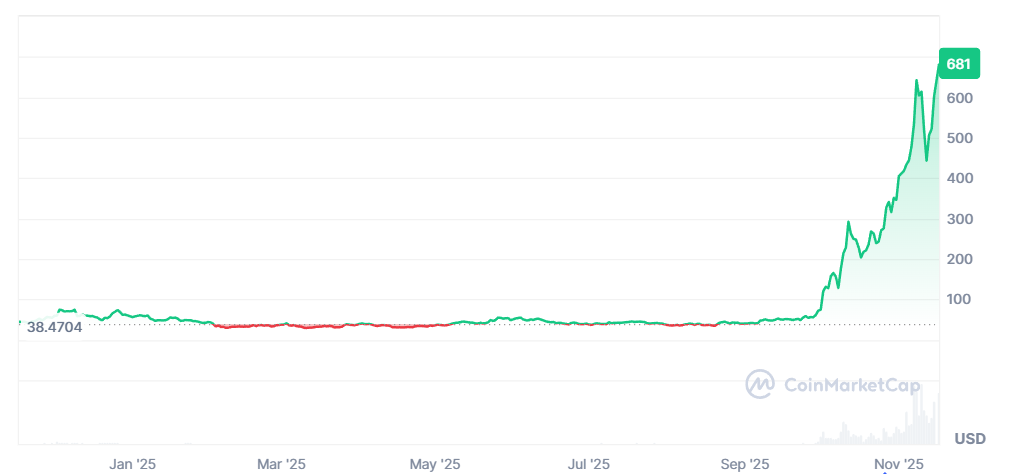
As interest returned, ZEC climbed rapidly and its Zcash market cap expanded enough to rival older mid-caps again.
This is the type of price pattern traders look for: long consolidation, heavy accumulation, then a strong breakout that shifts sentiment.
How to buy Zcash
If you want to learn how to buy Zcash, the process is simple: ZEC is listed on most major global exchanges. Traders can buy it with credit card purchases, bank transfers, or stablecoins, depending on the platform. Availability varies by region, but compared to other privacy coins, Zcash remains one of the easiest to acquire.
Choosing a Zcash wallet
If someone wants the full privacy experience, they need a Zcash wallet that supports shielded transactions. Some wallets only support transparent addresses, which defeats the purpose.
Mobile options like Zashi and desktop wallets built specifically for Zcash are usually the best choices for shielded transfers.
This also matters for people using ZEC for online services or privacy-sensitive transactions, including certain platforms that offer Zcash gambling features for anonymous betting. Without a shielded-compatible wallet, those privacy benefits disappear.
Dash (DASH): a classic project catching fresh momentum
Dash moved shortly after Zcash, and its breakout added even more fuel to the privacy narrative.
While Dash isn’t a fully private coin by default, its opt-in privacy features and long history as “digital cash” made it one of the first places traders rotated into once the sector started heating up.
What Dash is known for
Dash launched as a fast, low-fee payments coin built on top of Bitcoin’s original codebase. Its standout features include:
- Instant transactions through InstantSend
- Masternode governance, which handles network decisions and enhances stability
- Optional privacy through a built-in CoinJoin-style mixing feature in the Dash wallet
This combination of speed, simplicity, and flexible privacy is what kept Dash relevant even when the broader market ignored privacy assets.
Why Dash rallied
Once ZEC broke out, Dash became one of the easiest and most accessible follow-up plays in the niche. Several factors helped it gain traction:
- It had a long multi-year downtrend that traders were watching for a reversal.
- Liquidity remained solid because Dash stayed listed on many exchanges.
- Its chart structure showed clear resistance levels that, once broken, invited new buyers.
This created a clean technical setup. It’s the kind of structure that traders gravitate toward during sector rotations.
Dash price action
The recent Dash price move wasn’t as explosive as Zcash’s, but it was strong enough to pull in significant attention.
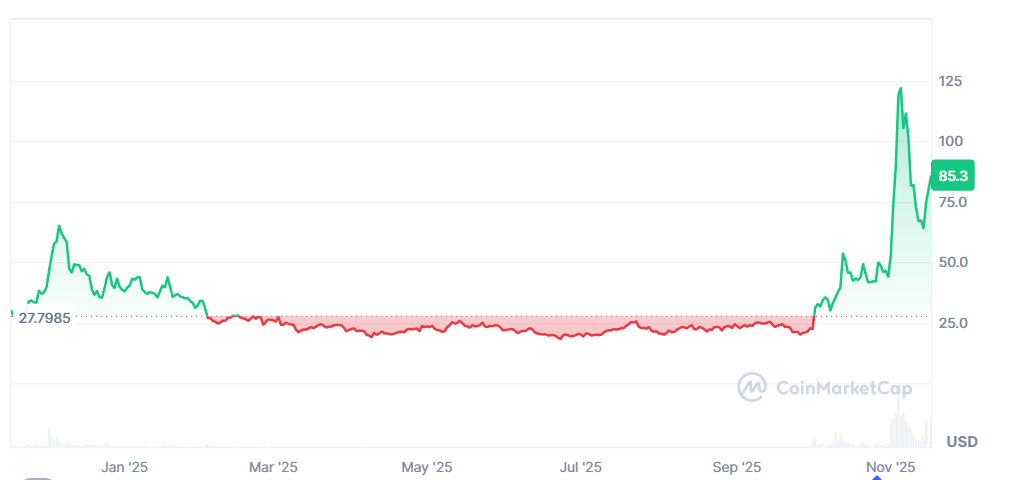
Dash regained levels it hadn’t seen in a long time, and the spike in volume reinforced confidence that the trend wasn’t a one-day fluke.
The broader takeaway is simple: Dash had been undervalued for so long that even a moderate catalyst was enough to kick off a sustained recovery.
How to buy Dash
Buying Dash is straightforward because the coin remains listed on many large exchanges. Users who want quick access can purchase it with bank transfers, cards, or stablecoins depending on the platform they use.
Dash’s availability is one of its biggest advantages compared to more restricted privacy assets.
Using Dash wallets
Dash’s official wallet supports the full feature set. It includes InstantSend for fast payments and CoinJoin for optional privacy. Other multi-coin wallets also support Dash, but users who want to enable privacy features typically choose the Dash Core wallet for maximum control.
Aster (ASTER): a new player benefiting from the privacy momentum
Aster isn’t a classic privacy coin, but it has still been pulled into this month’s surge. The reason is simple.
Traders aren’t just looking at old privacy projects anymore. They’re paying attention to anything building privacy into trading, execution, or on-chain activity. Aster fits that narrative perfectly.
What is Aster?
Aster is the token behind a multichain decentralized exchange focused on high-speed perpetual trading. The project emphasizes self-custody, deep liquidity, and advanced order execution features.
One of its standout ideas is hiding trade intent until execution, so that traders have more privacy and less chance of being front-run.
Because Aster positions privacy as a trading advantage, not just a payment feature, it naturally joined the broader “privacy rotation” once the sector started heating up.
Why Aster rallied
Aster had several tailwinds at the same time the privacy narrative exploded:
- Traders were rotating into overlooked altcoins with active development.
- Aster’s ecosystem continued expanding with new trading features.
- Its chart structure lined up with the same kind of technical breakout that lifted Zcash and Dash.
The combination of fresh development updates and strong market sentiment helped push it higher alongside the older privacy names.
Aster price performance
The Aster price climbed sharply during the same window that Zcash and Dash broke out.

The token has been volatile (like most assets in this niche), but the recent momentum brought it back into the conversation as one of the stronger mid-caps in the sector.
As liquidity increased, it became one of the main “adjacent plays” for traders who wanted exposure to privacy-related tokens without buying the older projects.
How to buy Aster
Buying Aster depends on the exchanges available in each region, but it’s generally accessible on platforms that list mid-cap altcoins.
It’s also available through decentralized exchanges, which is often the preferred option for users who want to stay fully self-custodial.
Why Aster matters in this narrative
The privacy rally isn’t limited to payment coins anymore. Aster is part of a newer wave of projects using privacy as a tool for better trading, not just anonymous transactions.
That broader angle is why it got swept into this month’s momentum and why some traders are watching it as a longer-term play.
Risks and regulatory challenges
The privacy coin rally looks impressive, but it comes with real risks.
These projects sit in one of the most heavily scrutinized parts of the crypto market. And whenever a narrative takes off this fast, it’s important to understand the pressure points behind it.
Regulatory uncertainty
Privacy coins have dealt with regulatory pushback for years. That hasn’t changed. Some regions restrict or discourage trading assets with anonymity features. Certain exchanges have previously removed coins like Monero or Dash during compliance updates.
Zcash has avoided some of the harsher restrictions because its privacy is optional, but the risk is always there. Any new policy announcement (even one not targeted specifically at these coins) can affect liquidity, exchange access, or user confidence.
Exchange availability
Because privacy assets sit under tighter scrutiny, they can be more vulnerable to sudden listing or delisting decisions. Even if a project is strong technically, losing access to major exchanges instantly reduces volume and makes price swings more violent.
This uncertainty is part of what keeps privacy coins volatile. Traders who hold them long-term need to be comfortable with the possibility that access may change depending on where they live.
High volatility
The same reason privacy coins can rally 80% in a month is the reason they can fall just as fast. These markets are smaller, more sentiment-driven, and react quickly to momentum shifts.
Sharp breakouts often lead to equally sharp corrections, especially when new buyers enter during the peak of excitement.
To be fair, this isn’t a problem unique to privacy coins. But the volatility tends to be amplified in this niche.
Privacy features are powerful, but not foolproof
Another underappreciated risk is misunderstanding how privacy technology works. Some wallets do not support private transactions, some features require manual activation, and in many cases users assume they are fully anonymous when they might not be.
For example, sending Zcash without a shielded-compatible wallet removes the privacy layer entirely. Using Dash without enabling its mixing feature results in a regular transparent transaction. These details matter, and beginners often overlook them.
Perception risk
Privacy coins face a unique challenge: they are often associated with “anonymous activity” in headlines, even when used for completely legitimate reasons. That perception alone can create market pressure when sentiment shifts or when regulators publish updates on AML or KYC rules.
This doesn’t stop their adoption, but it does influence how quickly institutions and exchanges are willing to support them.
The bottom line
The privacy coin surge didn’t come out of nowhere. It was a mix of long-term undervaluation, tightening regulations across the broader market, and a sudden wave of momentum that pushed overlooked projects back into the spotlight.
Zcash led the charge, Dash followed with its own technical breakout, and newer players like Aster showed that privacy-driven demand now extends beyond payment coins.
Whether this turns into a long-term trend depends on two things:
- Continued development from the projects themselves
- How regulators treat the privacy niche going forward
What’s clear is that the narrative has returned. After years of silence, traders are once again paying attention to privacy coins.



